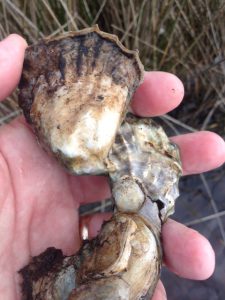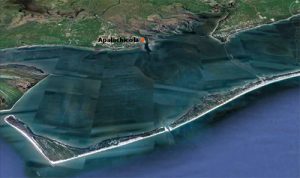Oysters…
I just about said “southern Gulf coast tradition”. But honestly, oysters are popular all over the world. Some of the biggest “oyster snobs” are in the northeast part of our country.
That said, we still link them to the Gulf coast. For a long period of time, Apalachicola provided 80% of the country’s oysters. It is a part of life here.

These delectable bivalves have been part of the human diet for many years. Exavated middens from ancient Native American dwellings and early European settlements show the animal was a big part of the diet. And why not! They are large, juicy, have a nice salty taste to them, and are easily harvested in shallow waters. Many probably selected their dwelling sites near the large oyster beds that could be found along here.
Today oysters are part of our holiday meals, tailgating parties, and family gatherings on weekends. Oyster shucking contest go on in many places and many driveways are made from the discarded shells from many happy meals. Several area restaurants specialize in them, and there are local dishes like charred oysters on a grill and gumbo that are definite favorites.
But who is this little creature that has caught our interest for so many years?
Well… most know that oysters are animals – small invertebrates belonging to a group called “mollusk”. Mollusk are known for their calcium carbonate shells which they secrete from a tissue called a mantle. Some mollusk secrete a single coiled shell (snails), others an internal one (slugs and squid), and then there are the bivalves – those secrete two shells, and it is this group to which the oysters belong.
Some bivalves can move about (clams and scallops) but others are stationary/sessile (oysters and mussels). Most of them are very popular seafood items. Oysters begin life as a drifting larvae called a veliger. Fertilized in the water by released gametes from nearby parents, they drift in the water column seeking suitable habitat to settle on. They will settle on almost anything hard. Bricks, seawalls, pier pilings, boats, even turtle shells will work – but they prefer to settle on other oysters forming oyster clumps. These clumps can grow into large oyster bars (or reefs) that line the shorelines of Gulf coast estuaries. Some oysters can grow up to 8 inches in length and some have been reported up to 11 inches. They prefer salinities in the 10-15 parts per thousand range and do best in the mid portions of area bays and bayous.

Photo: UF IFAS
They are filter feeders, feeding on a variety of microscopic food in the water. They can filter as much as 50-gallons of water / hour and play an important role keeping estuary waters clear and clean. The oysters can support a large diversity of marine organisms. Crabs, shrimp, worms, other mollusk, sponges, and numerous species of fish are associated with these reefs. They are magical places to snorkel and explore around.
In recent years, the oyster beds have suffered. A combination of environmental changes, storms, and overharvesting have taken their toll. The most famous issue is the “water wars” between Florida and Georgia. Water flow down the Apalachicola River has been restricted as it moves through the state of Georgia – for needs their communities have. This reduced inflow of freshwater has increased salinities in Apalachicola Bay to a point where more saline predators and diseases, such as oyster drills, have moved in. Too much rain will increase water flow above normal decreasing salinities and increasing nutrients and fecal bacteria. Excessive nutrients can trigger harmful algal blooms and enhance natural red tides. High levels of fecal bacteria will close the beds until conditions improve. Area oyster businesses used to replace old oyster shell back to the bottom of the bay providing habitat for new oyster larva to settle out as spat. Much of this shell material is now taken to a landfill and there is less settling habitat for the next generation. And there is still the issue of overharvesting.
In 2017, the commercial landings for eastern oysters in Florida was 831,250 pounds, 94% of this from the Gulf coast. This is 43% lower than it has been in the last five years. At one time 80 bags of oysters / oysterman was the norm. Today, 2-5 bags can be a good day.

Google Earth
To counter this problem oyster farming was introduced in the 1990’s. Early on it was not successful. It was found to be too labor intensive and too costly to grow. Clams were successful and the oyster farmers learned a lot from the clam industry. Today there are several oyster farming businesses in the state, including here in Pensacola – the Pensacola Bay Oyster Company, and there is hope these ventures will continue to supply the markets with local grown oysters.
We owe a lot to this small invertebrate that lives in our backyard. They are a special creature.
HAPPY OYSTER DAY!
References
Commercial Landing Summaries. Florida Fish and Wildlife Conservation Commission. https://public.myfwc.com/FWRI/PFDM/ReportCreator.aspx.
Havens, K. Climate Change; Effects on Salinity in Florida’s Estuaries and Responses of Oysters, Seagrass, and Other Animal and Plant Life. University of Florida IFAS Extension. Electronic Data Information Source. https://edis.ifas.ufl.edu/sg138.
Texas Parks and Wildlife. Eastern Oyster (Crassostera virginica). https://tpwd.texas.gov/huntwild/wild/species/easternoyster/.
 0
0
